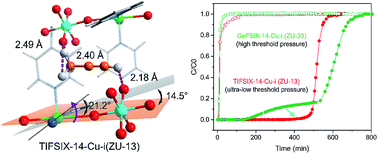A highly sensitive flexible metal–organic framework sets a new benchmark for separating propyne from propylene†
Abstract
The stepwise adsorption behavior endows flexible metal–organic frameworks (MOFs) with theoretically high separation selectivity; however, their practical separation performance for gas mixtures is frequently far inferior to the theoretical value from pure-component sorption isotherms due to their retarded and unpredictable response to gas molecules under the mixed gas environment, especially for trace gas removal. Here we reported a novel and highly sensitive flexible MOF (TIFSIX-14-Cu-i, also termed as ZU-13) featuring ultra-low propyne (C3H4) threshold pressure for efficient separation of trace C3H4 from propylene (C3H6), a critical step to produce polymer-grade C3H6. We revealed how exerting threshold pressure control in anion-pillared flexible materials enabled ultra-high sensitivity to targeted C3H4 molecules as well as obvious exclusion of C3H6 molecules through precise control of the hydrogen-bonding interaction between organic linkers and anion pillars. The designed TIFSIX-14-Cu-i with ultra-low C3H4 threshold pressure (500 ppm) not only exhibited exceptionally high C3H4/C3H6 selectivity (355) but also set a new benchmark for the separation of 1/99 C3H4/C3H6 mixtures (1280 mL g−1 with C3H6 purity over 99.9999%) in breakthrough experiments without disturbing the “leakage” phenomenon. The underlying mechanism of sensitive flexible MOFs for C3H4/C3H6 separation was revealed by density functional theory calculations.



 Please wait while we load your content...
Please wait while we load your content...